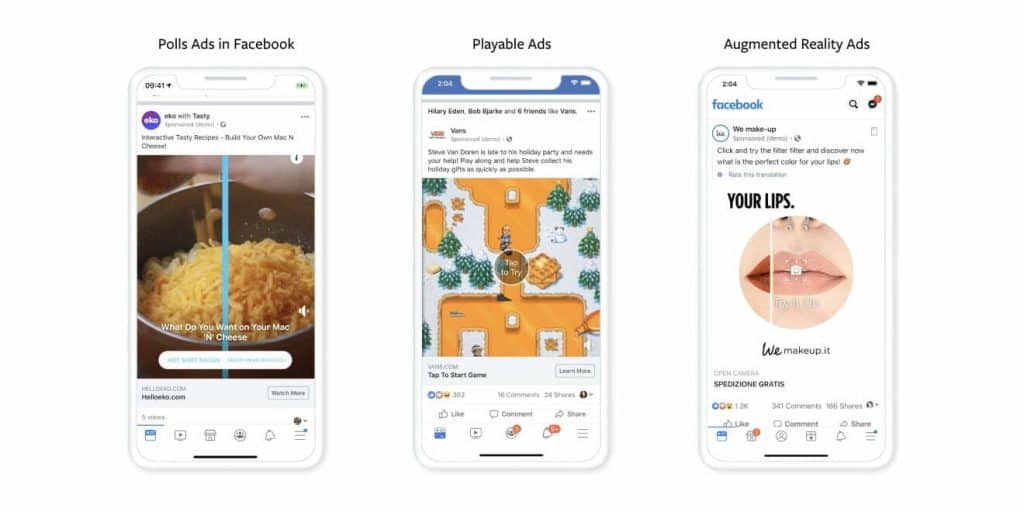Over the past decade, we’ve seen advertising and marketing trends evolve at a frequent and fast pace. Now that tech and commerce have become inexorably intertwined, brands must be able to swiftly adapt their strategies to meet the ever-changing needs of the modern consumer.
Interactivity has become one of the most effective tactics for engaging customers, especially as digital marketers face consumer privacy laws and the growing need to collect their first-party data. From playable ads and shoppable videos to metaverse-friendly technologies such as augmented and virtual reality (AR and VR), there’s no shortage of emerging platforms for businesses to take advantage of. Here’s a look at how the interactive landscape has changed in recent years and what’s in store for the future.
1. Discover the Power of Interactive Advertising
It’s easy to understand why adding interactive elements to digital ads increases customer engagement. In addition to encouraging users to become active participants in their immediate consumer experience, interactivity gives marketers insight into their audiences through data. This is no longer just a savvy tactic to help brands get an edge on the competition. Data-driven marketing has become the norm, and campaigns that do not leverage data and personalization to target audiences will fall short in today’s modern landscape.
But consumers’ growing call for transparency in marketing practices coupled with reformed data privacy laws have forced marketers to rethink their data collection strategies. Interactive ads have become one of the most effective ways to gather valuable consumer data while enhancing customer experience and encouraging brand loyalty.
It’s easy to understand why adding interactive elements to digital ads increases customer engagement. In addition to encouraging users to become active participants in their immediate consumer experience, interactivity gives marketers insight into their audiences through data. This is no longer just a savvy tactic to help brands get an edge on the competition. Data-driven marketing has become the norm, and campaigns that do not leverage data and personalization to target audiences will fall short in today’s modern landscape.
But consumers’ growing call for transparency in marketing practices coupled with reformed data privacy laws have forced marketers to rethink their data collection strategies. Interactive ads have become one of the most effective ways to gather valuable consumer data while enhancing customer experience and encouraging brand loyalty.
Playable ads are a prime example. Designed to mimic the experience of a game or mobile app, they draw users in with engaging interactive micro-moments. At the same time, they measure user behavior at key interactive touchpoints, collecting valuable engagement data for campaign optimization such as click-through rates, replay rates, share rates, and time spent on the ad.
53 percent of Gen Zers report engaging with rewarded mobile game ads. – Modern Mobile Gamer
Playable ads are also highly effective because users choose whether or not to engage with them. This helps weed out non-committed consumers, as well as boost user retention rates and drive a higher return on ad spend (ROAS).
When playable ads were first introduced in 2014, they were embraced mainly by mobile game developers because they allowed consumers to experience playing a game before committing to an app download. But today they’re used for all types of campaigns and brand interactions and feature a range of content elements, including videos and photo filters, to promote engagement.
2. Experiment With Shoppable Videos & Discovery Commerce
With 70 percent of web traffic now coming from mobile devices, mobile marketing has become an essential advertising strategy. And because smartphones and tablets are inherently interactive — requiring users to swipe, tap, and touch their way through each and every experience — mobile advertising is a natural platform for engaging audiences via interactivity. Add to that the fact that most people carry their smartphones with them wherever they go, making it possible for brands to reach consumers anytime, anywhere.
This is one of the reasons why shoppable videos have quickly gained traction via social media apps like TikTok and Instagram. Consumers — especially Gen Z and millennials — are relying more and more on social platforms to inform their shopping decisions, and they’re embracing interactive ads that allow them to choose which products they want to learn more about. Shoppable videos enable viewers to select and discover the items of their choice and purchase them instantly without leaving the video experience.
86 percent of shoppers say they prefer visual, actionable, and interactive content. – Demand Gen Report
In addition to promoting customer engagement, shoppable videos offer an improved user experience by aiding customers in their decision-making process. This helps build trust between consumer and brand and creates a connection that increases the likelihood of conversion. Shoppable videos also use interactivity to help guide potential customers to the products they are looking for, a digital sales tactic known as discovery commerce.
3. Dive Into AR, VR & Metaverse Marketing
According to the International Data Corporation, AR and VR market spend will reach $72.8 billion by 2024. The usage of these immersive technologies in marketing increased significantly during the pandemic, as they gave brands ways to enhance ecommerce activities and replicate in-store shopping experiences during lockdowns.
With metaverse hype at a high, smart marketers continue to look for ways to leverage AR and VR to reach new audiences and tap into new revenue streams. Brands are upping the ante for digital interactivity by engaging consumers in innovative and uncharted ways, and there are a number of key strategies emerging as major marketing trends in the metaverse.
For example, many brands are finding success recreating their real-life offerings in virtual environments, giving consumers the ability to actively engage in promotional experiences via digital avatars. This kind of parallel marketing, which includes buzzed–about deals like Gucci’s partnership with Roblox and Stella Artois’s collaboration with the digital horse-racing platform ZED RUN, provides companies with a familiar, authentic, and relatively simple way to introduce their brand into the immersive world of the metaverse.
As of late 2021, consumers had already spent $200 million on virtual services, goods, and other metaverse items. –Grayscale Research
There’s also direct-to-avatar (D2A) commerce, which sees brands selling virtual products directly to the digital identities that populate the metaverse. This strategy is critical to fashion and accessory retailers eager connect with Gen Z audiences, who have wholeheartedly embraced virtual reality and see their avatars as outlets for creative self-expression.
Gen Zers have also been major drivers of AR marketing trends, with 51 percent considering AR to be “very important” for entertainment and social connections. Beauty brands such as Sephora took the lead with AR filters and other try-on tools, which have been extremely effective in boosting customer interaction levels. And last year, Gucci made waves when it offered the Gucci Virtual 25, a pair of digital-only sneakers that users could try on via AR, purchase via the Gucci app, and “wear” in VR platforms like Roblox.
Interactivity Is Here to Stay
While the pandemic certainly expedited the demand for interactivity in digital marketing, the trend has been evolving rapidly over the last ten years and will continue to develop at a fast and furious pace. As mobile marketing explodes and the metaverse begins to take shape as an important advertising platform for Gen Z, more and more consumers expect interactive customer experiences that put them in the driver’s seat while making shopping easy and fun. Leveraging playable ads, shoppable videos, AR/VR, and other emerging platforms is a must for marketers looking to boost engagement and ultimately increase their sales.












